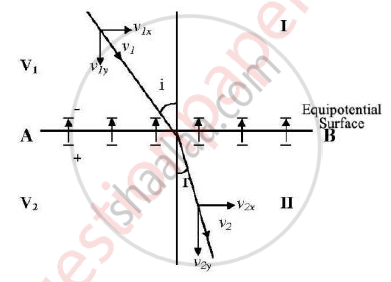Advertisements
Advertisements
Question
Derive Bethe’s Law for electron refraction.
Solution
Region I has potential V1 and region II has potential V2. The plane surface AB constitutes one of the equipotential surfaces. Let an electron with velocity v1 enter region I making an angle I with the normal. As the electron passes through the equipotential surface AB, it experiences a force which alters its velocity. Because the electric field exists only in the y-direction, the vertical component (y-component) of electron changes while the tangential component (x-component) remains constant.
𝑣1𝑥=𝑣2𝑥
𝑣1sin𝑖=𝑣2sin𝑟
`sin i /sin r=v_2/v_1`
If V1>V2, 𝑣1𝑦 increases while if V2>V1, 𝑣2𝑦 increases.

In our case we have taken V2>V1. As the electrons move through the electric field their kinetic energy is provided by the respective potential energy of the electric fields. Hence mv12/2=qV1
And mv22/2=qV2
Dividing the above equation we get,
v12/ v22= V1/ V2
v1/ v2=`sqrt(V1//V2)`
Hence we get,`sin i/sin r=(v2)/(v1)=sqrt((V2)/(V1))`
This is known as Bethe’s law of electron refraction.
